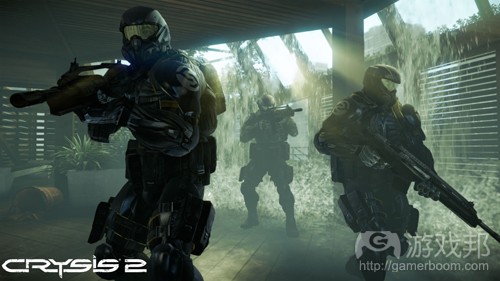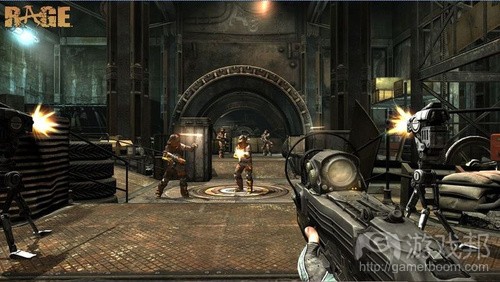游戏行业和玩家不应过于重视设备的播放帧率
作者:Mihai Cosma
数天之前,我与好友讨论可行的升级解决方案。尽管我提出了自己的建议,但他坚持进行成本颇高的升级。他提到自己希望游戏的帧率能够超过100fps,当我询问其原因时,他只是回答“为了让游戏玩起来更加流畅”。在现代硬件战争中,这似乎是个不断出现的主题。
首先,让我们讨论下FPS这个无处不在的术语。FPS指每秒帧数,是衡量显卡在渲染特定虚拟环境时每秒所呈现帧数的单位,显示的是硬件的处理能力。这已经成为行业标准,《孤岛危机》和《地铁2033》等游戏以及3dMark等工具成为标杆,可展示显卡的处理性能。我们经常会听到“我用Ultra上运行《孤岛危机2》时帧率达到50fps”这样的言论,这往往被众人视为它比运行相同游戏相同场景时帧率为40fps的显卡要好。
这种想法绝大部分是正确的,你使用较好的显卡当然能够获得更好的整体体验,但它并非完全正确。
事实上,FPS受到重视应归结于游戏玩家对它的认知。我们没有将FPS视为一种概念,而是希望我们的游戏看起来和玩起来都可以更棒。FPS的高低似乎已经同游戏流畅性密不可分,这种看法显然是错误的。
让我们来看看,我们是否应当一味追求更高的FPS。
每秒帧数指1秒时间内的平均播放帧数。假如你获得的帧率为60fps,并不能表明你在这一秒时间中的某些阶段看到这些帧。你可能刚开始看到10帧,随后画面暂停50毫秒,然后在剩余时间内看到另外50帧,那么帧率依然是60fps。当你每毫秒看到1帧时,帧率同样是60fps。结果是什么呢?在前一个例子中,你可能看到的是“停顿”的画面,而第二个例子中你可以看到流畅播放的视频,而这两者的帧率都是60fps。如果你想知道更多有关这个话题的信息,可以阅读Scott Wasson在The Tech Report上发表的文章《Inside the second》。
假设你在游戏中获得50fps的平均帧率,那么这可能意味着你在游戏中任意时刻的帧率都介于40和60间,也可能意味着游戏中50%的时间帧率为100fps,而50%的时间帧率下滑到5fps。当然,我知道我举的例子比较极端,但我只是想澄清自己的观点:
从纯工程学角度来看,FPS确实可以衡量处理能力。尽管我们可以期望通过提升帧率来获得更好的体验,但它只是同游戏中的某一秒或某个特定场景相关,不能也不应当成为提升整体游戏体验而去追求提升的对象。
让我们回头看看其他的媒体。电影和电视的运行帧率为24或30fps,而你从未见过有人抱怨这些媒介的FPS过低。你或许会说,它们不具有互动性,但这与我们讨论的话题并无关联。我们现在讨论的是运动错觉和流动体验。
我们都曾经在Youtube上观看过视频,享受从视频开始到暂停或完全停止的过程。当视频暂停时,我们很无奈,要么观看较低清晰度的视频,要么静静地等待视频缓冲完毕。我们的体验受到了影响,尤其当我们沉浸在视频中时发生这种情况,比如正在看一部很棒的电影或视频游戏预告片。
电子游戏中也会发生同样的事情。尽管我们多数人无法注意到60fps和80fps之间的差别,但是当帧率滑落到15fps我们就会注意到,于是我们就会产生必须“升级硬件设备”的想法。
《狂怒》的上市时间并不长,使用新引擎idTech 5。尽管最初视觉效果看上去充满瑕疵,但这确实是个不错的想法。它靠提升纹理和减小其他内容的呈现范围为玩家提供更加流畅的体验。视频质量会根据你的电脑配置进行调整,而这不需要你去修改各种设置,整个过程都自动由游戏来完成。
结果是什么呢?游戏可以流畅地运行。
我想要表达的观点是,包括客户在内的游戏行业中的所有人都认为,我们需要跟上标准才能保证游戏运行的流畅性。
主机已经靠其标准化配置先发制人,虽然它已经创造了奇迹而且不断使自己成为用户体验游戏的最“简单”方法,但游戏视觉效果质量却受到了影响。
让我们使用更加准确的衡量标准。
摒弃FPS,让我们使用IFR,也就是流畅度评级概念。我们也不要再过分纠结Vsync和屏幕撕裂问题,不过Nvidia正在开发解决这个问题的Adaptive Vsync技术。
回到问题的本源,让显卡性能通过IFR标准来衡量。强大的显卡可以以更好的IFR播放视觉效果要求较高的游戏,而性能较差的显卡也能够以100%的IFR运行独立游戏或视觉效果要求较低的游戏,也就是流畅的25毫秒帧时或让游戏中任何时刻的帧率都不低于40fps。
所以,现代显卡在它的包装盒上标注的不应当是“在Haven中获得9800分”而是“在Haven标准下标杆中呈现90%的IFR”,这意味着对于90%的标杆,该显卡能够流畅地呈现内容,另外10%的帧需要更长的处理事件,也就是说FPS将较低。
我们的最终目标应该是将用户对FPS术语的关注转向玩家真正应该关注的内容,也就是流畅的游戏运行过程。我相信,仍然会有狂热分子追求PC的升级和不断提升自己的FPS数值,但他们只是关注硬件和软件性能,这只是单纯的工程学追求。我只是认为,如果我们是出于享受游戏的目标,根本没必要这么做。
不幸的是,消费者、硬件公司甚至开发者似乎都不乐于使用这种面向体验的方法,而偏向于使用纯工程学的方法。这对某些人来说或许有益,但对游戏玩家来说并没有多大帮助。
我希望我们最终可以无需过于重视FPS,使用真正的标准来衡量游戏行业。(本文为游戏邦/gamerboom.com编译,拒绝任何不保留版权的转载,如需转载请联系:游戏邦)
The Illusion of Fluidity and the Evil FPS God
Mihai Cosma
I was discussing a possible upgrade solution for a friend a few days ago and he was adamant about getting an extremely costly upgrade, despite my best intentions. He mentioned he wanted to get “over 100 fps” in games and when i asked why, he just answered “to play games fluently”. And this seems to be a recurring theme in today’s hardware wars.
Let’s discuss the ubiquitous FPS term first. Frames per second, colloquially known as FPS, is a measurement of how many frames can a video card provide per second while rendering a given virtual environment, a raw representation of processing power. This has become an industry standard, along with games like Crysis and Metro 2033 and benchmarking tools like 3dMark, for illustrating the processing capabilities of video cards. It’s a common occurrence to say “i get 50 fps with Crysis 2 on Ultra”, and this is generally and inherently considered better than getting 40fps with a weaker video card on the same game with the same settings.
While the bulk of the idea is correct, you should get a better overall experience with the better card, it’s very far away from being completely true.
FPS relies on the perceived notion that we, as gamers, care about FPS. We don’t care about FPS as a concept, we care about having our games look good and play good. FPS seems to have attached itself like a parasite to the issues of game fluidity and wrongly so.
Let’s delve into that shall we?
Frames per second indicate the average of frames over a second. If say you get 60 frames per second, there’s no telling where in that second you got those frames. You could get 10 frames at start then pause for 50 milliseconds and then get another 50 frames, and you still have 60 frames per second. 60 frames per second you will also have when you get a frame every millisecond. The result? The first example you will experience as a “stutter”, while the second one you will experience as a smooth flow of video, both having the same ubiquitous 60 FPS. If you care to know more about this particular subject, read the great article by Scott Wasson at The Tech Report called “Inside the second” since we’ll diverge in a moment.
Going further, saying you get 50 frames per second average in a game might mean you get 40-60 frames per second at any moment in the game but it might also mean you get 100 frames per second 50% of the time with 50% drops to 5 frames per second. Again, i know i’m exaggerating, but only to make clear what i’m trying to say:
FPS is a raw measurement of processing power from a pure engineering point of view. While it can produce a somewhat correct expectation what our experience will be, it is only related to that one second or a particular scene and it isn’t and shouldn’t be a go-to figure for the whole experience.
Let’s draw it back a second. Movies and television run at 24 or 30 frames per second and you don’t see people complaining about low FPS in those mediums. You could say they are not interactive, but then again, it doesn’t matter. We’re discussing the illusion of motion and the experience of flow.
We’ve all been to Youtube at one time or another and had a video of something we were watching and enjoying start to stutter or stop completely. We then sighed and either dropped the quality of the video or waited for it to load a bit more. Our experience is then stained, especially if that happens at a point where you’re invested into the video, like a great movie or video game trailer.
The same thing happens in video games as well. While we most likely won’t notice the difference between 60 and 80 frames per second, it’s the 15 frame per second drop that we notice and that makes us consider “i should get an upgrade”.
RAGE came out not long ago and used a new engine called idTech 5. While initially it was rather buggy visually, the concept was great. It involved on the fly texture up and downscaling among other things, to provide for a smoother experience. The video quality adjusted according to how well your computer could run it and that’s without messing around with a dozen settings to tweak and done purely automatic by the game.
What was the conclusion? The game ran smoothly.
The point i’m trying to make is that the goal for everyone involved in the gaming industry, including the clients, come to the realization that, like the film industry, we need to adhere to a standard that preserves the illusion of fluidity.
Consoles have beaten us to the punch on that with their standardized configuration, and while that has done wonders and keeps making consoles an ‘easy’ way to get into gaming without hassle, the visual quality suffered, as can be seen with all the limitations in today’s console games.
Let’s go wild a bit.
Instead of FPS, let’s have an IFR, an Illusion of Fluidity Rating based on a generalized ideal of each frame-return of 25 milliseconds, as in, 40 frames per second. For the sake of the discussion, we’ll not go into Vsync and screen tearing although it appears Nvidia is working on a great technology called Adaptive Vsync which will solve this issue.
Returning to the matter at hand, video card performance will be listed in IFR standards. More powerful graphics cards would have a better Illusion of Fluidity Rating with more visually-demanding games, while even less powerful cards could play all the indie/less demanding games with maximum 100% IFR, as in, a smooth 25 milliseconds frame time or a minimum of 40 frames per second at any given moment in the game.
So a modern video card can say on its box, instead of “gets 9800 points in Haven”, “gives 90% IFR in Haven benchmark”, which would mean that for 90% of the benchmark, the card will offer a smooth rendition, with 10% of the frames having a longer processing time, thus, averaged, a lower FPS.
The goal in the end is to switch the focus from the engineering FPS term to the fact that actually concerns us as gamers, smooth gameplay. While i’m sure there will still be enthusiasts that upgrade and overclock their PC’s and brag with high FPS numbers, they actually care about the hardware and software capabilities and it’s an engineering endeavor as much worth pursuing as tuning your car or your musical instrument. I merely wish we wouldn’t have to always have that be a pressing concern in order to enjoy our games.
Sadly, it seems both consumers, hardware companies and even developers shy away from an experience-driven method of doing things to a pure engineering way which might impress people in the know, but it does nothing to help me or you enjoy our experience within a game.
I hope, for the sake of a better game and the renegation of such worries that detract from a pleasant gaming experience and hobby enjoyment, that we will finally move away from the FPS God and embrace a new, healthy, mentality that will benefit all of the gaming industry. (Source: Gamasutra)










































 闽公网安备35020302001549号
闽公网安备35020302001549号